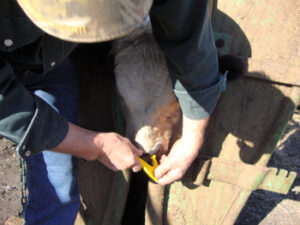Reducing Weaning Stress
This is a guest post written by Karin Schmid, Beef Production Specialist with the Alberta Beef Producers.
It’s approaching quickly, that time of year when you start to think about weaning your calves. Calves are weaned to make sure that cows can recover their body condition after raising a calf all summer, and to allow for specialized feeding of those calves. All producers do it, but not everyone approaches weaning in the same way.
The most common method of weaning is the abrupt separation of calves from their dams. This method is arguably the most stressful event of a young calf’s life. Not only are the calves abruptly deprived of a ready source of milk, but also social contact with their dams. Then add vaccinations, dietary changes, and transportation to a different environment, with unfamiliar animals, and it’s easy to see why weaning is stressful on calves. Stress depresses the immune system, which makes freshly weaned calves the most susceptible to bovine respiratory disease (BRD) infections.
Alternative weaning methods exist, if you are willing to spend a little more time on the process.
Fenceline weaning, where cows and calves are separated but still have nose-to-nose contact, is one option. This method is not labour intensive, but does require proper fencing to keep the cows and calves apart.

Another method, commonly referred to as two-stage weaning, uses an anti-suckling nose-tag to prevent the calves from nursing. The calves wear these tags for 4-7 days while remaining with the cows. When the tags are removed, the calves are also separated from the dams. This method requires one extra trip through the chute, but using calm and quiet handling methods will help to minimize stress on both the calves and the handlers.
But are these alternative methods actually less stressful? First we have to quantify stress in a beef animal. In a research setting, hormones, such as cortisol, can be measured to estimate stress levels. If a spike in the amount of cortisol is found, it is generally accepted as an indication that a stressful event has occurred. However, producers don’t have the means to measure cortisol levels, so they must rely on other indicators. Usually, animal behaviour is examined for signs of stress. Increased vocalizations, and the amount of time spent eating versus amount of time spent walking or pacing are common behavioural indicators of stress. While these methods would have to be evaluated subjectively on-farm, there are objective, scientific measurements of these behaviours that can provide insight into the amount of stress an animal may be experiencing.

Research by Dr. Derek Haley, a veterinarian and assistant professor at the Ontario Veterinary College in Guelph, focuses on weaning stress and ways to mitigate it. His research has shown that calves that were fenceline weaned vocalized 50% less, walked less, and had higher weight gains in the first 10 weeks after separation, than abruptly weaned calves. Calves that underwent two-stage weaning (with the anti-suckling nose-tags) vocalized 97% less, spent 30% more time eating, and walked 73 kilometers less than their abruptly weaned counterparts. In addition, the dams of the two-stage weaning calves vocalized 84% less.
Dr. Haley’s research indicates that alternative weaning methods result in fewer observed behavioural indicators of stress during the weaning process. These methods more closely imitate the natural weaning process, where a cow rejects a calf’s attempts to nurse over a two-week period when the calves are anywhere from 7 to 14 months of age, which may be the reason why behavioural measures of stress are so reduced in the fenceline and two-stage weaning processes.
Further research is exploring whether calves that are weaned using the two-stage process experience measurable health benefits at the feedlot level. Just like stressed humans, stressed cattle are more susceptible to disease, so reducing stress should have positive benefits on animal health.
Other ways to reduce stress at weaning include:
- familiarizing yourself with and practicing low-stress handling methods (including loading and unloading trailers for transport),
- gradually transitioning calves onto new feed to avoid reduced intakes, and,
- if possible, move the cows to the new location rather than moving the calves.
Performing procedures such as dehorning and castration at a young age when soft tissue damage will be minimized and healing will be quicker also reduces stress at weaning. The current Code of Practice for Beef Cattle recommends that these procedures be performed at an early age, preferably before weaning. In fact, delayed castration (at weaning or later) causes a reduction in growth rate that completely erases any growth benefits obtained by leaving the testicles intact up to that point.
There you have it. Minimizing calf stress at weaning is not only possible, but provides important animal welfare benefits, and likely animal health benefits as well. It just takes an open mind towards different methods and an eye towards good management.
The sharing or reprinting of BCRC Blog articles is welcome and encouraged. Please provide acknowledgement to the Beef Cattle Research Council and list the website address, www.BeefResearch.ca.
We welcome your questions, comments and suggestions. Contact us directly at info@beefresearch.ca or generate public discussion by posting your thoughts below. Stay connected by following us on Twitter @BeefResearch, liking us on Facebook, and subscribing to our YouTube Channel.